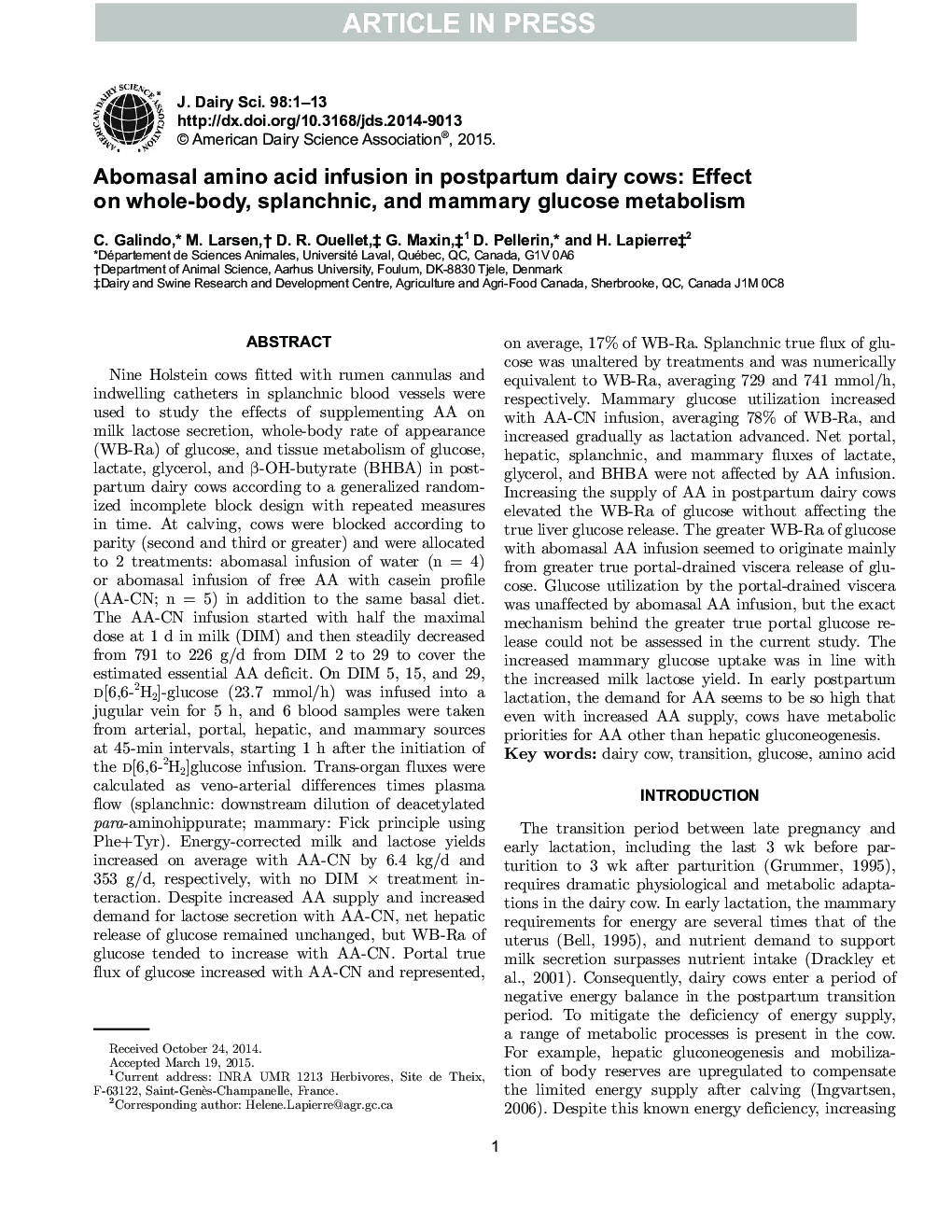| کد مقاله | کد نشریه | سال انتشار | مقاله انگلیسی | نسخه تمام متن |
|---|---|---|---|---|
| 10974563 | 1108026 | 2015 | 13 صفحه PDF | دانلود رایگان |
عنوان انگلیسی مقاله ISI
Abomasal amino acid infusion in postpartum dairy cows: Effect on whole-body, splanchnic, and mammary glucose metabolism
ترجمه فارسی عنوان
انسداد اسید آمینه آبوماسال در گاوهای شیرده پس از زایمان: اثر متابولیسم گلوکز کل بدن، اسپلنیک و پستان
دانلود مقاله + سفارش ترجمه
دانلود مقاله ISI انگلیسی
رایگان برای ایرانیان
کلمات کلیدی
گاو شیری، گذار، گلوکز، آمینو اسید،
موضوعات مرتبط
علوم زیستی و بیوفناوری
علوم کشاورزی و بیولوژیک
علوم دامی و جانورشناسی
چکیده انگلیسی
Nine Holstein cows fitted with rumen cannulas and indwelling catheters in splanchnic blood vessels were used to study the effects of supplementing AA on milk lactose secretion, whole-body rate of appearance (WB-Ra) of glucose, and tissue metabolism of glucose, lactate, glycerol, and β-OH-butyrate (BHBA) in postpartum dairy cows according to a generalized randomized incomplete block design with repeated measures in time. At calving, cows were blocked according to parity (second and third or greater) and were allocated to 2 treatments: abomasal infusion of water (n = 4) or abomasal infusion of free AA with casein profile (AA-CN; n = 5) in addition to the same basal diet. The AA-CN infusion started with half the maximal dose at 1 d in milk (DIM) and then steadily decreased from 791 to 226 g/d from DIM 2 to 29 to cover the estimated essential AA deficit. On DIM 5, 15, and 29, d[6,6-2H2]-glucose (23.7 mmol/h) was infused into a jugular vein for 5 h, and 6 blood samples were taken from arterial, portal, hepatic, and mammary sources at 45-min intervals, starting 1 h after the initiation of the d[6,6-2H2]glucose infusion. Trans-organ fluxes were calculated as veno-arterial differences times plasma flow (splanchnic: downstream dilution of deacetylated para-aminohippurate; mammary: Fick principle using Phe+Tyr). Energy-corrected milk and lactose yields increased on average with AA-CN by 6.4 kg/d and 353 g/d, respectively, with no DIM à treatment interaction. Despite increased AA supply and increased demand for lactose secretion with AA-CN, net hepatic release of glucose remained unchanged, but WB-Ra of glucose tended to increase with AA-CN. Portal true flux of glucose increased with AA-CN and represented, on average, 17% of WB-Ra. Splanchnic true flux of glucose was unaltered by treatments and was numerically equivalent to WB-Ra, averaging 729 and 741 mmol/h, respectively. Mammary glucose utilization increased with AA-CN infusion, averaging 78% of WB-Ra, and increased gradually as lactation advanced. Net portal, hepatic, splanchnic, and mammary fluxes of lactate, glycerol, and BHBA were not affected by AA infusion. Increasing the supply of AA in postpartum dairy cows elevated the WB-Ra of glucose without affecting the true liver glucose release. The greater WB-Ra of glucose with abomasal AA infusion seemed to originate mainly from greater true portal-drained viscera release of glucose. Glucose utilization by the portal-drained viscera was unaffected by abomasal AA infusion, but the exact mechanism behind the greater true portal glucose release could not be assessed in the current study. The increased mammary glucose uptake was in line with the increased milk lactose yield. In early postpartum lactation, the demand for AA seems to be so high that even with increased AA supply, cows have metabolic priorities for AA other than hepatic gluconeogenesis.
ناشر
Database: Elsevier - ScienceDirect (ساینس دایرکت)
Journal: Journal of Dairy Science - Volume 98, Issue 11, November 2015, Pages 7962-7974
Journal: Journal of Dairy Science - Volume 98, Issue 11, November 2015, Pages 7962-7974
نویسندگان
C. Galindo, M. Larsen, D.R. Ouellet, G. Maxin, D. Pellerin, H. Lapierre,
